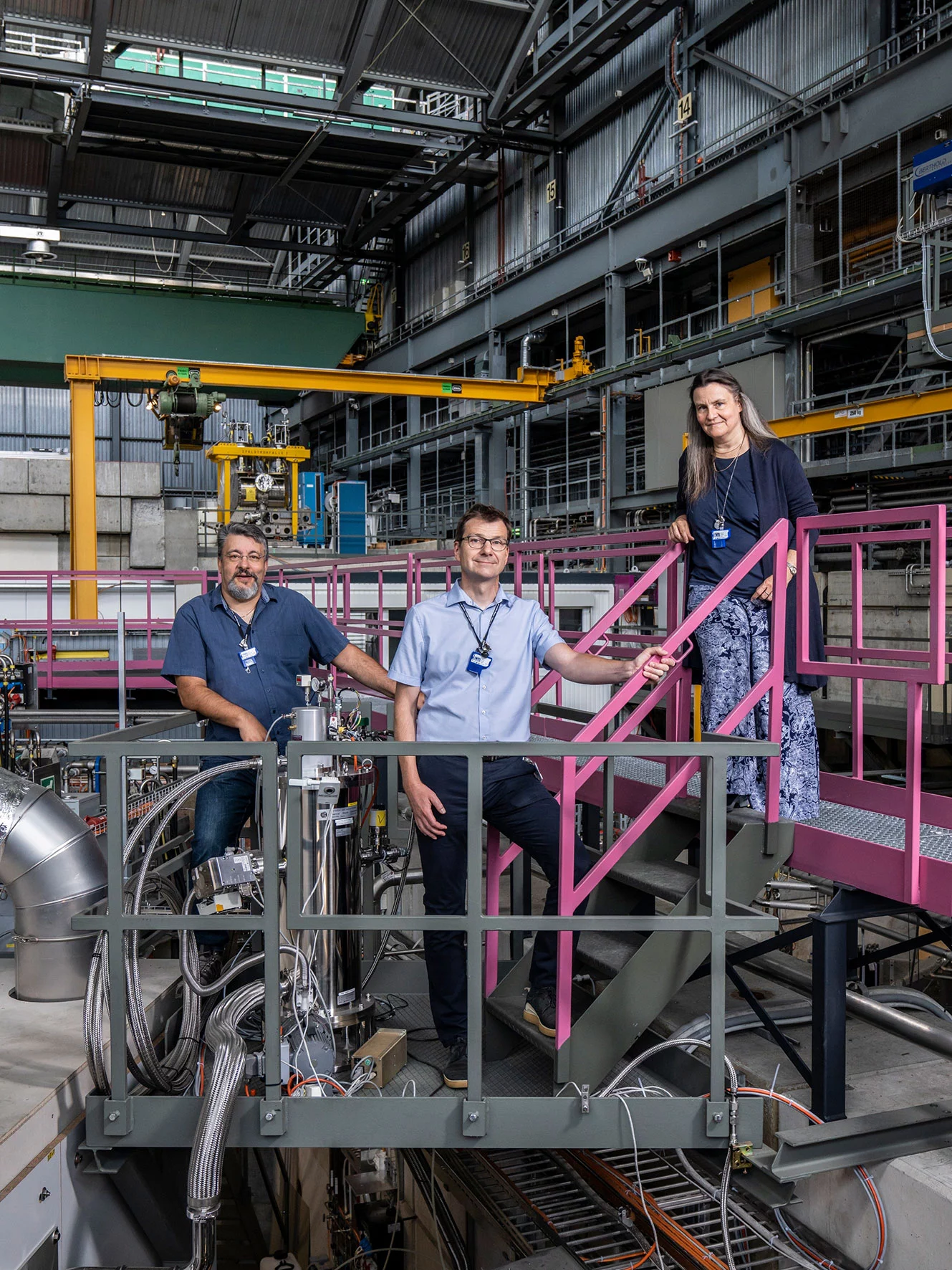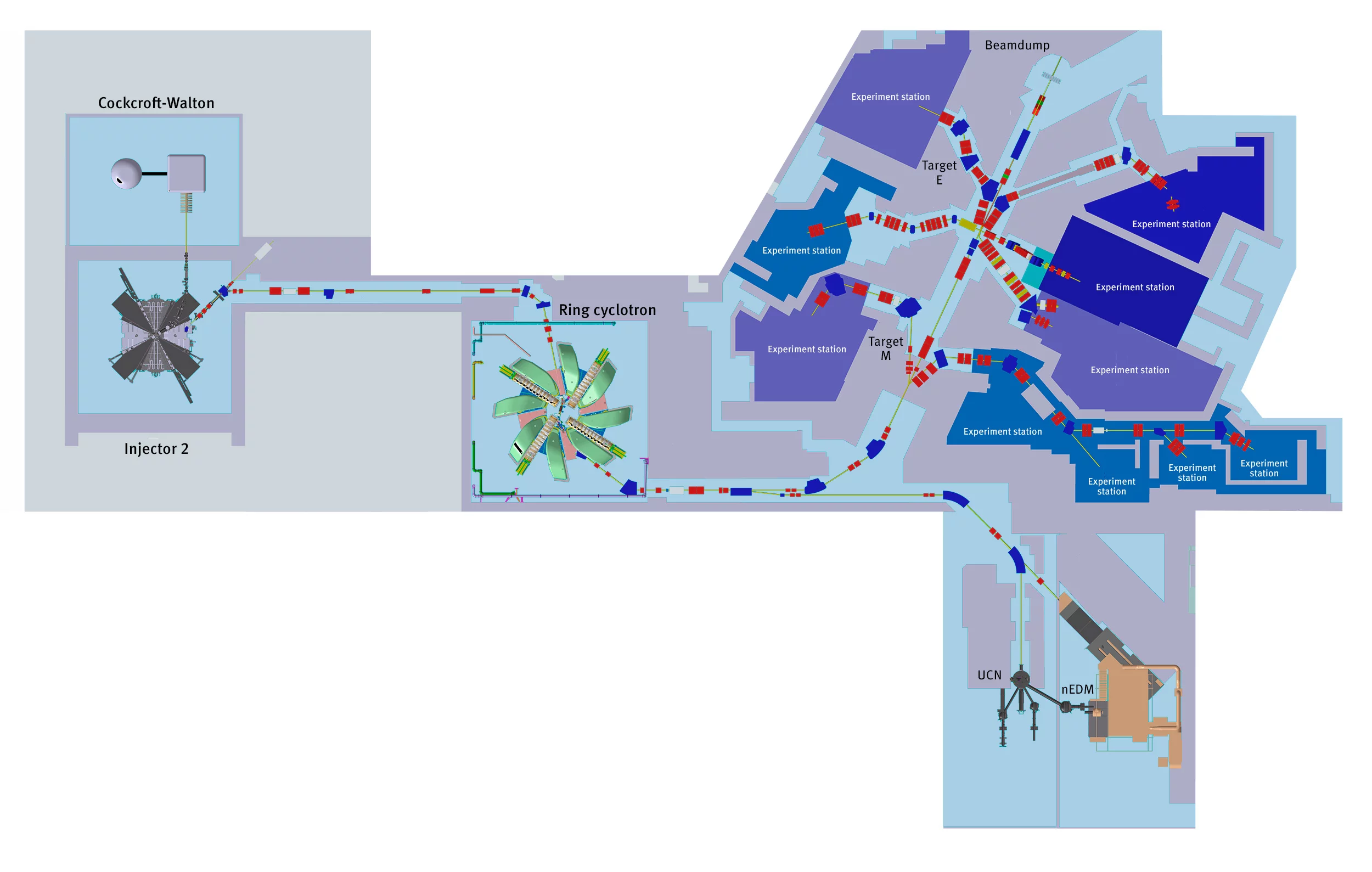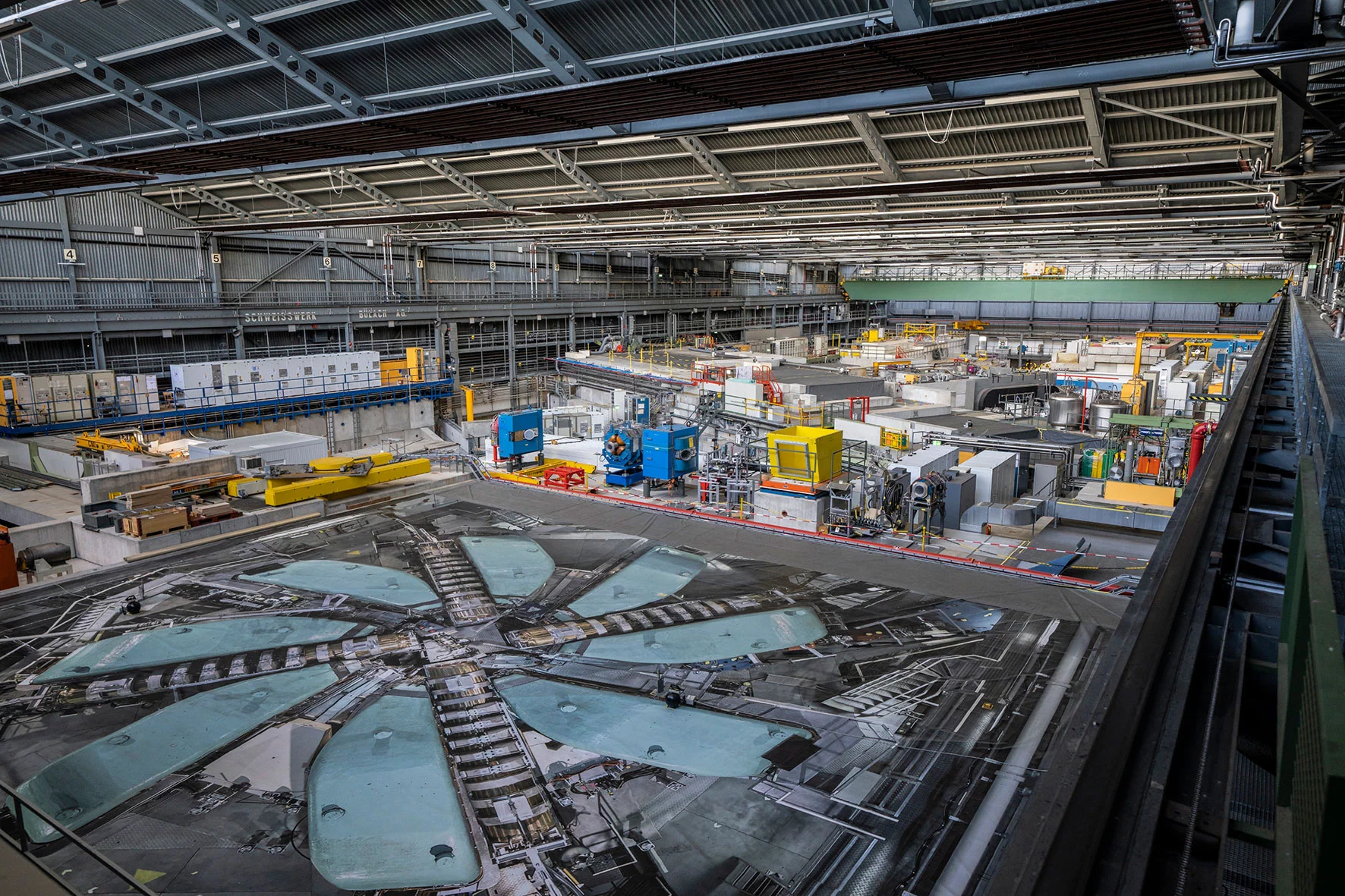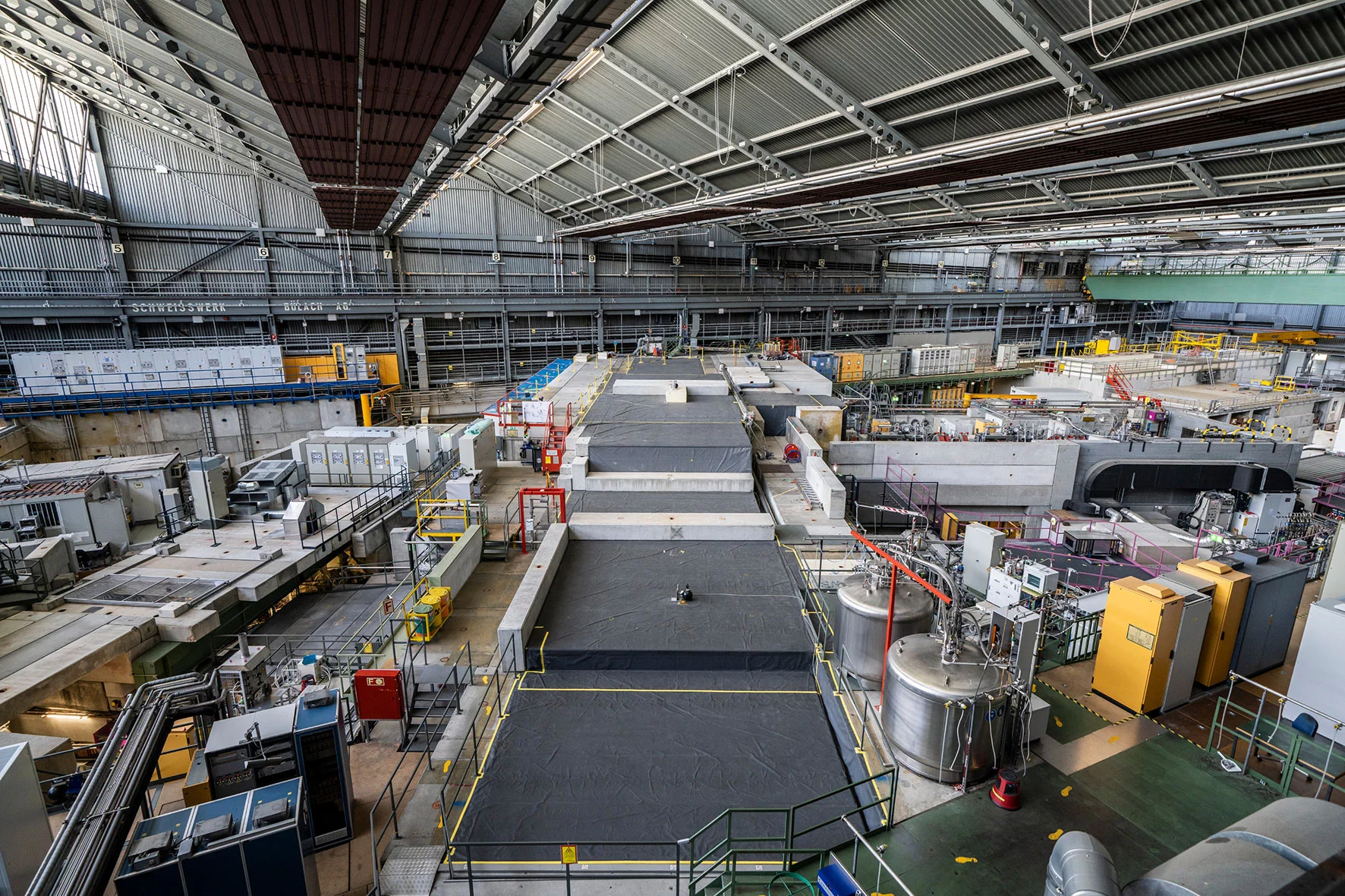With the high-intensity proton accelerator HIPA, the Paul Scherrer Institute generates elementary particles to clarify a fundamental question: How is our universe structured? With the help of pions, muons, and neutrons, the researchers are conducting experiments to find out how the well established yet incomplete Standard Model of elementary particle physics can be extended. The PSI facility is the best machine for this purpose worldwide, because at low energies it delivers more of the necessary particles than any other comparable facility.
(Photo: Paul Scherrer Institute/Markus Fischer)
(Graphic: Paul Scherrer Institute/Mahir Dzambegovic)
(Photo: Paul Scherrer Institute/Markus Fischer)
(Photo: Paul Scherrer Institute/Markus Fischer)
To do research on the smallest things in the universe, you often need big facilities. Hardly any other place at PSI makes this clearer than in some of the large halls in the western part of the Institute. There, researchers are working on solving the mystery of what, at the heart of it, holds the world together. A chain of three particle accelerators, each housed in its own hall, helps them do this. These devices serve the purpose of accelerating protons, the positively charged building blocks of atomic nuclei, to 80 percent of the speed of light.
The process begins at the mushroom-shaped, roughly 10-metre high Cockcroft-Walton accelerator, in which the protons are obtained and pre-accelerated. From there they make their way through a beam path to the so-called Injector 2, a ring accelerator or cyclotron. With the help of radio-frequency fields in resonators between large magnets, the protons continue to pick up speed and leave the facility at 38 percent of the speed of light. They then get the final boost in the large proton accelerator, also a ring accelerator, with a diameter of 15 metres. The magnets whose fields act on the protons here weigh up to 240 tons. From this ring accelerator, which stands behind metre-thick shielding in the corner of a large experiment hall, the proton beam is guided into the middle of the hall, because there it has reached a goal of its fast-paced journey: the so-called target facility.
The most important parts of this system are two graphite wheels, each with a diameter of about half a metre, which rotate once per second. First, the proton beam hits Target M, whose graphite wheel is only 2 millimetres thick. M stands for "mince", French for thin. Then the protons fly on to Target E, which is comparatively thick at 40 millimetres, thus "epaisse". If the fast protons strike the atomic nuclei of the graphite, pions form. These are the lightest of the particles that consist of quarks, made from two quarks rather than three like the protons and neutrons in the atomic nucleus. Pions belong to the family of mesons, a group of particles whose existence was predicted in the 1930s and confirmed experimentally in 1947. Most of the time, pions decay into muons within a split second. Muons resemble the electron but are around 200 times heavier.
Particle physics and materials science
The thicker Target E produces more muons than the thinner Target M. This provides a more sharply defined pion beam. The pions and muons are guided from the targets to various measuring stations with the help of magnets. At PSI, pions and muons are generated at low energies. This means that the particles are slow and can be stopped in the apparatus for experiments. In three measurement areas, researchers conduct experiments in particle physics to clarify fundamental questions about the universe and its structure. A further five experiment stations are available for solid-state physics. Here, with the help of muons, knowledge can be gained that will later flow into practical applications. For example, magnetic fields inside materials can be determined very locally, and thus storage media for computers can be improved. "Our facility gets a lot of use, because we have the most intense proton beam worldwide and thus the highest muon production", says Daniela Kiselev, who is responsible for the operation of the accelerator and target systems. Nowhere else are there so many slow pions and muons as at PSI in Villigen.
"Originally, the ring accelerator was built as a pion factory", explains Klaus Kirch, head of the Laboratory for Particle Physics at PSI and professor at ETH Zurich. "Today, however, researchers are doing a lot more experiments with muons than with pions." Both pion and muon experiments can be used to precisely test the current particle physics theory and to look for new insights that go beyond this Standard Model. Because it definitely has some weak points.
The standard theory explains what the visible world is made of and what, at the heart of it, holds things together. This means that it describes all known elementary particles and the forces that act between them. But the fundamental questions remain open: Why does any matter – and why do we – exist in the first place? And what else is the universe made of? According to the standard model of cosmology, equal proportions of matter and antimatter were created in the Big Bang, the birth moment of our universe. "But today we see nothing of this antimatter any more", explains Kirch: "Certain processes must have seen to it that the antimatter has disappeared, but part of the matter has survived."
How that could have happened is one of the great mysteries of physics. Just like the nature of the so-called dark matter. According to astronomical observations, this makes up a large part of the mass of the universe, but it does not consist of the elementary particles known to us. These findings about the cosmos cannot be explained with current theory. "We do not yet know how we should revise the standard theory so that we can explain these observations", says Kirch. "But we have a series of experiments we use to look for things that do not appear in the standard model and thus might provide clues as to what the right extension of the theory could be."
Null isn't nothing
So the researchers at PSI are searching for muon decays that the standard model says should not occur. Like pions, muons are also unstable. After a life span of about two millionths of a second, three particles usually arise from a positively charged muon: a positively charged electron – that is, a positron – and two neutral particles with very low mass, so-called neutrinos. What has never been observed, on the other hand, is the breakdown of a muon into just two particles: a positron and a light particle – a photon or gamma particle. With the MEG experiment, an international group at PSI recorded hundreds of trillions of muon decays over the years without detecting a single event of this kind. "But we didn't measure "nothing", we measured a zero, and that is something completely different", emphasizes Stefan Ritt, head of the Muon Physics Group at PSI.
The null result indicates how likely or unlikely this decay is, and means that some theories can already be rejected as an extension of the Standard Model. Now the international group is working on a new experiment at PSI that is ten times more sensitive. MEG II is scheduled to start in 2022. At the same time, another international collaboration is building a second experiment called Mu3e. It should show whether the muon can also decay into three electrons – likewise, an event that has never been seen before. "The experiments complement each other, so both are needed", Kirch explains. And his colleague Ritt says: "If we find these decays, this really is new physics – a new force of nature or a new, heavy elementary particle that lies behind it." And maybe an explanation for dark matter.
Also at CERN near Geneva, researchers are also searching for clues to a theory beyond the Standard Model. There, protons are accelerated to almost the speed of light with the giant accelerator LHC and collide with extremely high energy. The PSI High Energy Physics Group is involved in the CMS experiment at the LHC and is making substantial contributions. In Villigen, the researchers are experimenting in a lower energy range. "Our experiments are one or two orders of magnitude smaller and cheaper, but uniquely sensitive and relevant", says Ritt.
Developing new detectors
The detectors for the new experiments MEG II and Mu3e are currently being developed at PSI. The position and time of the particle decays, as well as the energy of the particles, must be measured more and more precisely. "We are at the forefront of detector technology and hold world records", says Ritt, who is involved in both experiments. He is particularly proud of the development of electronics with a semiconductor chip that measures the signals of particle decays with an accuracy of one millionth of a millionth of a second (a picosecond). In the meantime, the technology is being used at universities for educational purposes and to improve medical facilities for tumour detection. PSI has already shipped 500 copies of this handy device worldwide. It is about ten times cheaper than previous measuring devices.
In particle physics, the researchers at PSI rely not only on muons, but also on neutrons. These uncharged building blocks of atomic nuclei are also generated using the accelerator. The proton beam knocks them out of a target made of lead. Then they are slowed down sharply until they are ultracold. For these ultracold neutrons (UCNs), the UCN Source at PSI is a global leader. Ultracold neutrons are very slow and can be stored and examined for a few minutes. Particle physicist Kirch explains: "Seen from the outside, a neutron has no electrical charge, so it is neutral. But maybe it has an asymmetrical charge distribution inside." The experts speak of an "electric dipole moment" of the neutron.
According to the standard model, the neutron electric dipole moment is immeasurably small compared to today’s experimental sensitivities. If it were to appear in the experiment, there would be a good chance of finding an explanation for why there is matter in the universe but apparently no original antimatter. Because the same phenomenon may lie behind the excess of matter and an asymmetrical charge distribution in the neutron. The physicists call it "symmetry violation". Over two years, an international group working at PSI has measured the properties of the neutron more precisely than ever before with the nEDM experiment, but the researchers were unable to demonstrate an electric dipole moment – another null result as in the muon experiments. Here too, certain theoretically possible explanations can now be ruled out. And here too, the researchers are currently developing a follow-up experiment, n2EDM, to check still more precisely whether or not an electric dipole moment can be detected in neutrons.
Exploring the inside of the proton
Although the null results bring exciting insights, Klaus Kirch concedes: "I also like to do experiments in which I measure something that is not zero." He and other members of PSI and ETH Zurich, together with international partners, are investigating how electrical charge and magnetism are distributed in a proton. For that the researchers use negatively charged muons that form special atoms instead of electrons. An ordinary hydrogen atom consists of one proton in the atomic nucleus and one electron in the atomic shell. If the electron is replaced by the 200 times heavier muon, it comes much closer to the proton and even spends time inside it. Thus measurements on the muon enable new insights into the proton.
At PSI in 2019, around 400 researchers in all worked on nine different experiments in particle physics. Given its proud age of 45 years, the facility's performance could seem astounding. Today it delivers 25 times more intensity than what it was originally planned for. "Through regular maintenance and investments in innovations and upgrades, we have continued to develop the system and keep it fit for the future", says Daniela Kiselev. Just recently a new type of graphite wheel was tested that boosts the rate of the slow muons by 40 to 50 percent. On the accelerator side, two resonators will be replaced, which will accelerate the protons even more efficiently and with less loss. There is also constant investment in the infrastructure. In recent years, for example, the pipes that supply cooling water have been replaced bit by bit, and the power supplies for the many magnets in the system that keep the protons on their path have been replaced. This means that PSI researchers will continue to gain exciting and ultimately useful insights into the fundamental building blocks of our world.
Text: Barbara Vonarburg
Contact
Prof. Dr. Klaus Kirch
Head of Laboratory for Particle Physics
Paul Scherrer Institute, Forschungsstrasse 111, 5232 Villigen PSI, Switzerland
Telephone: +41 56 310 32 78
E-mail: klaus.kirch@psi.ch [German, English]
Dr. Stefan Ritt
Laboratory for Particle Physics
Paul Scherrer Institute, Forschungsstrasse 111, 5232 Villigen PSI, Switzerland
Telephone: +41 56 310 37 28
E-mail: stefan.ritt@psi.ch [German, English]




